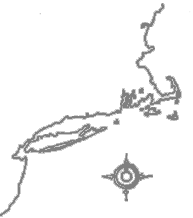
Sea Secrets
Sea Connections
Ocean Market
Pollution Solution
Stranded Along the Coast
Reflections on the Sea

|
Not only do these forces shape the land, they affect the living populations. Sometimes animals that inhabit deeper water are thrown off course. They come close to the shoreline and may actually be found on the beach. They may be injured, sick, or disoriented and soon become cold, hungry, or dehydrated. Such is the case for various species of dolphin, porpoise, seal, whale, and turtle that become stranded along the Atlantic coastline. But there is help for some animals. In many locations, when beached animals are sighted, professionals and volunteers are on the scene. Sick, cold, or injured animals are immediately placed in a rehabilitation program with the intent of getting them well enough to be returned to their natural habitat. Often the animals are tagged with a transmitter for future tracking.
Some of the large marine animals that are regularly tracked along the Atlantic coast are cetaceans, pinnipeds, and sea turtles. Cetaceans are marine mammals such as whales, dolphins, and porpoises; pinniped refers to seals and walruses. If an individual from one of these populations is seen on shore, the observer can call in the sighting to an agency that helps such creatures; if possible, a rescue team is dispatched. Every acknowledged animal sighting is assigned a number and becomes part of the database for that species. If the animal requires treatment of an injury or disease, it may be given a temporary tank to live in until it can recuperate and be returned to the wild.
Sea turtles make up another group of marine animals that become stranded along the Atlantic coast. Turtle species are of particular interest because they are either endangered or threatened worldwide. (Endangered species are in danger of becoming extinct; threatened species could easily become endangered if present trends continue.) Sea turtles are reptiles that have existed virtually unchanged for eons; human activity has decimated their populations. In the days of the great sailing ships, these large reptiles often found their way into the cook's stewpot. Their heavy shell or carapace was a treasured source of decorative shell. Even in recent decades, their eggs have been plundered for food.
During their long lives (fifty years or more), these reptiles may travel great distances; tagging individuals is important for studying their behavior and monitoring their dwindling populations. Stranded sea turtles are sometimes reported up and down the Atlantic coast as well as on the Gulf Coast. The causes are many, including water pollution, disease, attack by a predator, or entanglement in fishing gear. To prevent turtles from getting caught and drowning in fishing nets, some Gulf shrimp trawlers use nets equipped with a turtle exclusion device that has been effective in protecting turtles.
On the northeast Atlantic coast, animals are sometimes found close to the beaches, especially in the winter months. They may be driven toward the shore by the cold Labrador current in Cape Cod Bay, or the northwest winds along Long Island's north shore may pin the turtles against the shore or trap them in bays. These animals become "coldstunned"-chilled to the point where they are unresponsive and unable to eat to get their metabolic rate going. Coldstunned turtles must be gradually warmed, given warm fluids intravenously, and then force-fed to give them the nutrition they need. When their body temperatures have increased, they are placed in tanks and fed and cared for until they are sufficiently recovered to be released.
The data in the activity reflect actual turtle strandings during the winter months of 1995 reported by the Okeanos Foundation on Long Island and the New England Aquarium in Boston, agencies that are authorized to rescue and rehabilitate marine animals.
![]()
[ Essay | Procedure | Student Pages | Resources | Next Lesson ]
educate@si.edu
